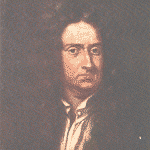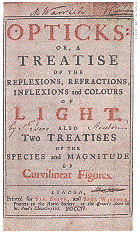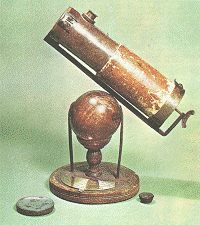
 |
How it works : Newton,Sir Isaac |
NEWTON, Sir Isaac (1642-1727)
 |
Above : Isaac Newton when he was 60, in 1702, a copy of Godfrey
Kneller's portrait. Newton was grey before he was 40; here he wears a wig.
About this time, he had changed from being a withdrawn academic to a hardened
administrator, used to dealing with the coin clippers and counterfeiters
who were prosecuted by the Mint |
On the early morning of Christmas Day 1642, in a Lincolnshire farmhouse, was born the greatest scientific genius the world has known. Isaac Newton was a premature and tiny baby, and the midwives who went off to get medicines for him doubted whether he would be alive on their return. Yet from these undistinguished origins arose the man whose mind laid the foundations of many branches of modern science.
Isaac's father, an illiterate yeoman farmer, had died three months previously Although the cottage at Woolsthorpe is described as a manor house, and Isaac Newton became in effect lord of the manor, he was not heir to any fortune and he was expected to become a working farmer like his father.
 |
Newton's Opticks, not published until 1704, after his arch-enemy Hooke had died. Only then would Newton accept the presidency of the Royal Society, though he had been a leading member for over 30 years. In 1705 he became the first scientist to be knighted. |
His background did allow him to receive a. good schooling in the local day schools and, later, in nearby Grantham. He was by no means an outstanding scholar-he was not very interested in the classical studies of the day, and spent much of his time making working models and studying the world around him. When prompted by his schoolmaster, by such tricks as placing him low in the class, he would make a successful effort to shine at his schoolwork. All his pocket money, however, went on buying tools so that he could make better gadgets.
Newton's mother had married a local vicar and gone to live with him when Newton was only four, leaving him in the care of his grandmother: this may well have had a traumatic effect on him, affecting his later relationships with people.
When he was in his early teens, however, his stepfather having died, Isaac had to return to Woolsthorpe to help with the farm. He was of less use than his mother had hoped. When tending sheep, for example, he would get so engrossed with a book, some invention, or in watching the stream, that the sheep would very likely get into the corn. Once, when returning from Grantham, he dismounted for a hill, forgot to remount and plodded home leading the horse, deep in thought. Through out his life, Newton had the reputation of being a true absent minded professor.
His schoolmaster recognized the intellect that was within Newton, and persuaded his mother to let him return to school. When Isaac eventually went to university at Cambridge, the farm workers reckoned that was all he was good for, and would never make anything of himself.
Newton's degree was undistinguished, but at Cambridge he met Isaac Barrow, then professor of mathematics, who must have sparked off something within Newton for shortly after wards the dreamy-eyed boy began to concentrate on his most original work. In his graduation year, 1665, when Newton was 23, bubonic plague broke out in England and he returned to Woolsthorpe to avoid it. It was here that all the influences on him had their effect: he looked back on those two years of seclusion at his mother's cottage as the most significant of his life.
Isaac Newton himself was the source of the famous story that while sitting in the orchard on a warm autumn afternoon, the fall of an apple to the ground set him wondering about the nature of gravity. Talking later, he said that he wondered why the apple always fell towards the centre of the Earth, and reasoned that all matter attracts the rest of matter to it.
At Woolsthorpe, too, he performed his experiments on the nature of light, passing white light through a PRISM to produce a spectrum (Newton's word) of colours. He realized that white light is no more than all the colours seen together, and made many more investigations into the nature of LIGHT and OPTICS.
All this time, he was developing his ideas on MATHEMATICS, resulting in the discovery of the calculus or, as he called it, the 'Method of Fluxions'.
On Newton's return to Cambridge, Barrow stepped down in favour of him as professor of mathematics. One might imagine that Newton would publish the results of his work as soon as possible; actually he seems to have had little desire to publish, and when he did produce his results it was only at the insistence of others.
Newton's introduction into the full swing of academic life came with his election to the Royal Society in 1672 when he made the first working reflecting ASTRONOMICAL TELESCOPE. He gave a paper reporting his works on optics, and at once fell foul of Robert HOOKE, who upheld the wave theory of light as against Newton's corpuscular theory. Actually, both were right in their own way (see QUANTUM THEORY).
Hooke and Newton quarrelled many times over the years; there were also bitter debates as to whether Newton or the German mathematician Leibniz had invented the calculus. The truth is that many of Newton's discoveries were in the air at the time, and would before long have been put forward by others; but Newton's skill and genius tied the loose ends together to produce the final results.
 |
| Above: the reflecting telescope made by Newton for the Royal Society. The system is still known as the Newtonian design. This telescope has a concave mirror of 1.3 inches (3.4 cm) diameter and just over 6 inches (15 cm) focal length. |
The Principia, which describes the works on DYNAMICS summarized by NEWTON'S LAWS of Motion and Gravitation, was published in 1684, and Opticks in 1704. By this time Newton, seeking a more prominent situation than that of a mere academic, took on an important post at the Royal Mint, where he played a large part in revising the coinage system.
Newton never married, though there were romantic tales of a childhood sweetheart. He seems to have reserved his attentions for work only. He spent a vast amount of time studying theology, ALCHEMY, and the chronology of ancient civilizations, but his work on these subjects is now practically forgotten. In his own day, as now, his work on physics and mathematics made him an internationally renowned figure. When he died in 1727, he was buried in Westminster Abbey, an honour previously reserved for monarchs, politicians, soldiers, and other such worthies.
Reproduced from HOW IT WORKS p1586